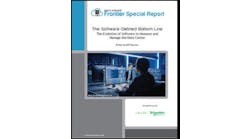Microsoft’s 'Sustainable By Design' Initiative Seeks to Transform Data Center Water Efficiency
The name of Microsoft's recently announced blog series announcing new initiatives in transforming data center water efficiency says it all: Sustainable by Design. With a goal toward building more sustainable data centers, Microsoft starts with optimized workloads and zero water consumption.
The company, a leader in cloud computing and AI, has recognized the environmental challenges posed by these facilities and has there undertaken extensive efforts to reduce water consumption in its operations.
Facing Pressure on Water Resources
Water plays a crucial role in cooling data centers, where high-performance computing means generating substantial heat. And with the adoption of AI being deployed in data centers, the need for cooling is growing at an almost exponential rate.
Traditionally, cooling systems have relied on evaporative methods, consuming large quantities of water and as the demand for AI, HPC, and conventional cloud services grows, so does the pressure on water resources.
Addressing this issue is vital not only for reducing the environmental footprint but also for supporting communities in water-stressed regions, where significant pressure from local governments can result in data center development being postponed or prevented altogether.
Microsoft’s approach to water conservation is rooted in its broader sustainability goals, including becoming carbon negative, water positive, and zero waste by 2030. Achieving these goals requires innovative technologies, operational excellence, and meaningful community engagement.
As of 2023, Microsoft had already invested in almost 50 water replenishment projects worldwide. These investments include projects such as land conservation, aquatic habitat restoration, water supply reliability, and water quality improvements.
A Multi-faceted Strategy for Water Usage Improvements in Data Center Deployments
The first step in Microsoft’s new data center design is to minimize water usage through efficient operations and the latest cooling technologies, primarily direct-to-chip liquid cooling. The approach includes:
- Optimized Temperature Control: By operating data centers at higher ambient temperatures, it is possible to reduce the need for cooling systems that consume water. Outdoor air cooling is leveraged whenever possible.
- Audits and Predictive Models: Regular audits identify inefficiencies in water usage. For example, issues identified in a 2022 audit were addressed and eliminated 90% of excess water use instances. Predictive models, based on real-time weather and operational data, enable proactive adjustments to water requirements.
- Localized Conservation Strategies: In water-scarce regions, Microsoft employs strategies tailored to local conditions, such as using reclaimed and recycled water in Texas, California, and Singapore or harvesting rainwater in countries like Ireland, Sweden, and the Netherlands.
- Cold Plates: This direct-to-chip cooling technology dissipates heat efficiently through a closed-loop system, reducing or eliminating the reliance on traditional air or evaporative cooling methods.
- Microfluidics: Advanced chips integrate tiny fluid channels, bringing cooling directly to the processors. This innovation enhances efficiency and precision, reducing overall water usage.
- Zero-Water Evaporation Systems: Starting in August 2024, Microsoft introduced data centers optimized for AI workloads with zero water evaporation cooling designs. These systems recycle water in a closed loop, avoiding any requir4ment to use fresh water, which resulted in conserving up to 125 million liters of water annually per data center when compared to traditional evaporative cooling.
Microsoft tracks its water efficiency through Water Usage Effectiveness (WUE), which measures water consumption per kilowatt-hour of energy used. Recent documented improvements include:
• A 39% reduction in WUE since 2021, reaching an average of 0.30 L/kWh in 2023.
• An 80% decrease in water intensity since the early 2000s.
As these measures go back a few years, it is clear that the low-hanging fruit in terms of improved water usage is quickly being addressed. The current expectation is that future advancements in zero-water cooling designs will bring WUE levels close to zero across Microsoft’s global data center infrastructure.
While transitioning from evaporative cooling to mechanical systems increases energy usage, Microsoft mitigates this impact with high-efficiency economizing chillers and elevated cooling temperatures. Research and development efforts continue to refine cooling technologies, ensuring sustainable growth in data center operations.
Pilot projects in Arizona and Wisconsin aim to validate zero-water evaporated designs, setting the stage for broader implementation across new data centers by 2027. These innovations identify Microsoft’s efforts to become an industry-leading user of efficient technologies and action to lead the industry toward a more sustainable future.
Local and Global Data Center Community Interaction Pledge
The company's "Datacenter Community Pledge" highlights Microsoft’s commitment to benefiting local communities.
It’s achieving these goals via ecological restoration, such as the water reclamation projects mentioned above, which are focused on assuring that the environment around their data center is not adversely impacted, and is in fact, improved.
These efforts also include rainwater harvesting and recycled water usage, reducing the dependance, and impact, of the data center on municipal water systems.
Microsoft is also taking an active role in advocacy for water policies. The company is supporting research and policy development to promote effective water management, including partnerships with tribal nations and state governments to enhance water security.
Educational and Economic Opportunities
There is also an organized effort to provide educational and economic opportunities to the local communities. Collaborations with schools, nonprofits, and local governments provide digital skills training, STEM education, and well-paid job opportunities.
While significant employment accompanies the construction of data centers, the benefits of corporate investment in education often leads to not just jobs within the data center community, but also attracting other technology-oriented business to co-locate in the areas where data center development has led the way.
In addition to investing in people, Microsoft is also committing to investing in community infrastructure. Beyond just building appropriate access to the data centers, they have seen their data center investments contribute to public services such as improved roads, parks, and schools, and overall elevating the quality of life in the communities around the data center.
Conclusion
Microsoft’s efforts to reduce water usage in data centers are an example of not only the company’s commitment to environmental sustainability and community well-being, but also a demonstration of the leadership role they are taking for how the future of the data center industry has to evolve.
Through innovative technologies, tailored conservation strategies, and meaningful partnerships, the company is setting an obtainable standard for water efficiency in the tech industry. By aligning its operations with local needs and global sustainability goals, Microsoft demonstrates that data centers can be both the backbone of modern technology and a force for good in the communities they serve.






